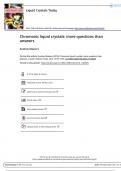Liquid Crystals Today
ISSN: 1358-314X (Print) 1464-5181 (Online) Journal homepage: http://www.tandfonline.com/loi/tlcy20
Chromonic liquid crystals: more questions than
answers
Andrew Masters
To cite this article: Andrew Masters (2016) Chromonic liquid crystals: more questions than
answers, Liquid Crystals Today, 25:2, 30-37, DOI: 10.1080/1358314X.2016.1149925
To link to this article: http://dx.doi.org/10.1080/1358314X.2016.1149925
© 2016 Taylor & Francis
Published online: 09 Mar 2016.
Submit your article to this journal
Article views: 782
View related articles
View Crossmark data
Citing articles: 2 View citing articles
Full Terms & Conditions of access and use can be found at
http://www.tandfonline.com/action/journalInformation?journalCode=tlcy20
Download by: [168.151.122.32] Date: 29 September 2017, At: 0
, LIQUID CRYSTALS TODAY, 2016
VOL. 25, NO. 2, 30–37
http://dx.doi.org/10.1080/1358314X.2016.1149925
RESEARCH ARTICLE
Chromonic liquid crystals: more questions than answers
Andrew Masters
School of Chemical Engineering & Analytical Science, University of Manchester, Manchester, UK
ABSTRACT ARTICLE HISTORY
While much liquid crystal research is on either thermotropic liquid crystals or on lyotopic, Received 28 January 2016
surfactant systems, a fascinating third class of materials is that of chromonic liquid crystals. Accepted 30 January 2016
These systems show fascinating properties but are, as yet, poorly understood. This article reports KEYWORDS
a recent meeting in which the status of our current knowledge is reviewed. Chromonic; nematic;
hexagonal; smectic; phase
diagram; computer
modelling; templating;
biosensors; active matter
Downloaded by [168.151.122.32] at 01:31 29 September 2017
Introduction anything like a critical micelle concentration. Instead,
one has a wide distribution of stack sizes, with the
While thermotropic liquid crystals are arguably the main
average size increasing with concentration. At high-
focus of liquid crystal research and application, lyotropic
enough concentrations, these stacks become long
systems show fascinating science not shown by their
enough to permit a transition to a nematic phase
thermotropic cousins and they also have their own area
and then, at higher concentrations still, to columnar
of practical application. Most work on lyotropics has
phases. As will be discussed below, however, there are
focussed on surfactants or amphiphiles. Here, one typi-
interesting exceptions to this general rule and the
cally has a hydrophobic alkyl chain attached to a hydro-
phase behaviour can be a lot richer than this.
philic head group and, as one increases the surfactant
In Manchester, United Kingdom, we held a small
concentration in water, the amphiphilic molecules aggre-
meeting on 24–25 March 2015 to review the current
gate into micelles. This transition from monomers to
state of knowledge about chromonic systems and,
micelles is quite sharp in nature and occurs at the critical
arguably more importantly, to look at the gaps in our
micelle concentration. If one increases the amphiphile
knowledge and formulate areas for future research. The
concentration still further, one may observe nematic, hex-
participants were a mix of synthetic organic chemists,
agonal, cubic, lamellar and a whole host of other liquid
experimental physical chemists and physicists, engi-
crystalline phases. This behaviour has been studied exten-
neers, modellers and theoretcians. The format was
sively and the basic understanding of the driving forces
that of short presentations followed by discussions.
for these transitions is, at the risk of sounding complacent,
While it is impossible to cram all the content into one
reasonably well understood.[1]
brief article, I shall attempt to give a flavour of some of
Another class of lyotropic molecules are the chro-
the main conclusions and outstanding issues.
monics.[2,3] These typically consist of a rigid-hydro-
phobic disc, usually composed of aromatic rings, with
solubilising groups round the edges. Many dyes come
Molecular structure and bulk behaviour
into this category. In most of the examples studied to
date, the solubilising groups are ionic. Examples are Ideally, we would like to be able to look at the mole-
edicol sunset yellow (ESY) and nylomine red, shown in cular structure of a chromonic mesogen and, from this,
Figure 1. Much less studied, however, are molecules in have a good idea as to how the molecules will aggre-
which the solubilising groups are nonionic. An exam- gate and what phases they will form. As noted above,
ple is 2,3,6,7,1,11-hexa-(1,4,7-trioxa-octyl)-triphenylene this seems to be the case with amphiphilic systems, so a
(TP6EO2M), shown in Figure 2. similar level of chromonic understanding would clearly
In solution, these molecules tend to aggregate to be desirable.
form stacks. There is, however, no optimal size for a To do this, one needs to synthesise a range of mole-
stack, so one never sees monodisperse micelles or cules and characterise their physical properties and
CONTACT Andrew Masters andrew.masters@manchester.ac.uk
© 2016 Taylor & Francis




